11 Best Native Plants for Virginia
BY LASHONDA TUCKER | MAY 8TH, 2023 | LAWN CARE, VIRGINIAAfter seeing the plethora of Virginia native plants displayed at the Virginia Living Museum, you may want a colorful and diverse exhibit of your own to show off. You can maintain your enjoyment and connection to nature by filling your garden with Virginia native plants. Here’s a list of the best native plants for Virginia and its five regions.
- Best Native Plants for Your Virginia Yard
- Best Native Plants for Southeast Virginia
- Best Native Plants for Northern Virginia
- Best Native Plants for Virginia’s Capital Region
- How to Choose Native Plants for Your Virginia Landscape
- FAQ About Native Virginia Plants
- Where to Find Native Plants in Virginia
Best Native Plants for Your Virginia Yard
1. Black-Eyed Susan (Rudbeckia hirta)
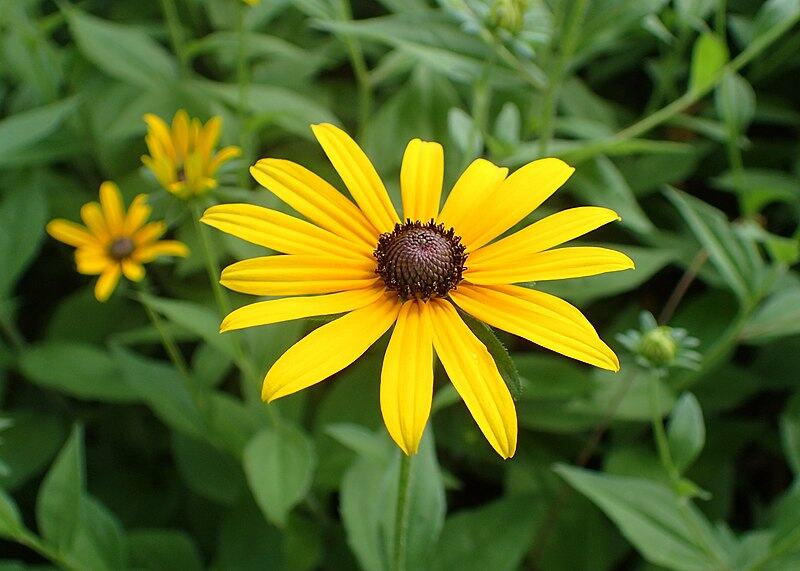
Photo Credit: Krzysztof Ziarnek, Kenraiz / Wikimedia Commons / CC BY-SA 4.0
Black-eyed Susan is common throughout Virginia. Since the wildflower’s hardiness zones include 5a to 8a, it should survive the coldest temperatures in every region of the state.
Black-eyed Susan looks like a daisy. Susan has long, bright yellow petals emerging from a dark brown center. She attracts birds, butterflies, and pollinators. The young plants are hardy enough to tolerate frost, making black-eyed Susan well-suited for the cold Virginia winters, especially the freezing winter temperatures in Northern Virginia, the Southwestern Mountain Region, Piedmont Region, and Western Mountain areas.
Black-eyed Susan has moderate drought tolerance once established and is very easy to grow. She tolerates a variety of soil types. If your home gets a lot of sunlight and some shade, it will provide a great place for this flower to thrive. Black-eyed-Susan works well in borders, beds, or as an accent plant.
Native Regions: All
Plant Type: Flower
USDA Hardiness Zone: 3 to 9
Sun: Full sun
Soil: Clay, sandy, loam, acidic, moist, well-drained
Duration: Can be perennial, biennial, or annual depending on growing conditions
Fragrance: Sweet
Bloom Time: Spring to early autumn
Water Needs: Medium. Has moderate drought tolerance
Mature Height: 1 to 3 feet
Maintenance Needs: Low
2. Cutleaf Coneflower (Rudbeckia laciniata)
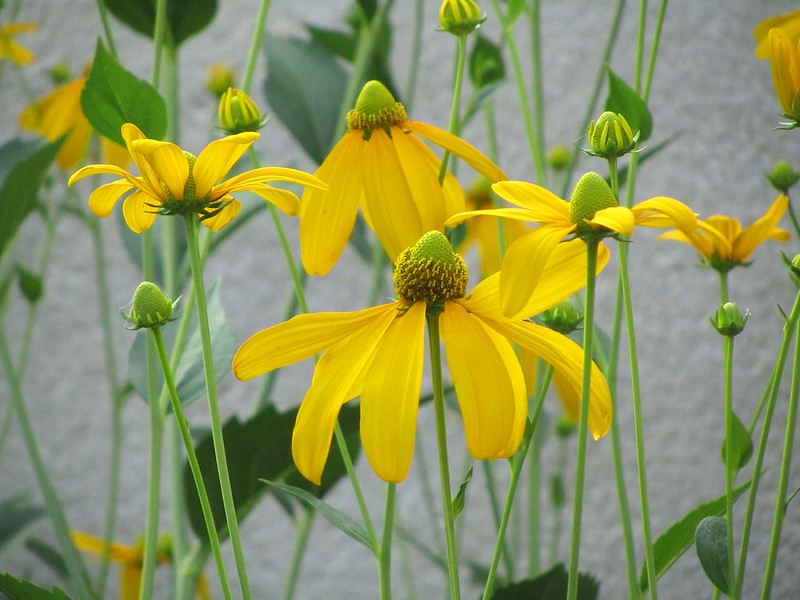
Photo Credit: Katja Schulz / Flickr / CC BY 2.0
Cutleaf coneflower is native to all five regions of Virginia. This brightly colored yellow flower has multiple petals stacked on top of each other. Like black-eyed Susan, cutleaf grows along the roadside, except cutleaf is generally found in roadside ditches. The leaves at the stem’s base remain in the winter, making this coneflower an excellent year-round groundcover.
Cutleaf is easy to grow. It thrives in full sun, full shade, or partial shade. Cutleaf’s nectar attracts butterflies. In the fall, songbirds flock to the coneflower’s seeds. If deer are prone to stop by your home, you’ll be happy to know that deer tend to ignore this plant. Cutleaf looks great in borders, beds, and cottage gardens.
Native Regions: All
Plant type: Herb
USDA Hardiness Zone: 3 to 9
Sun: Full sun, partial shade, full shade
Soil: Moist, slightly acidic soil
Duration: Perennial
Bloom time: June to November
Water needs: Low
Mature height: Up to about 10 feet tall
Potential hazards: Somewhat toxic to livestock
Maintenance: May need staking in some garden situations
3. Whorled Tickseed (Coreopsis verticillata)
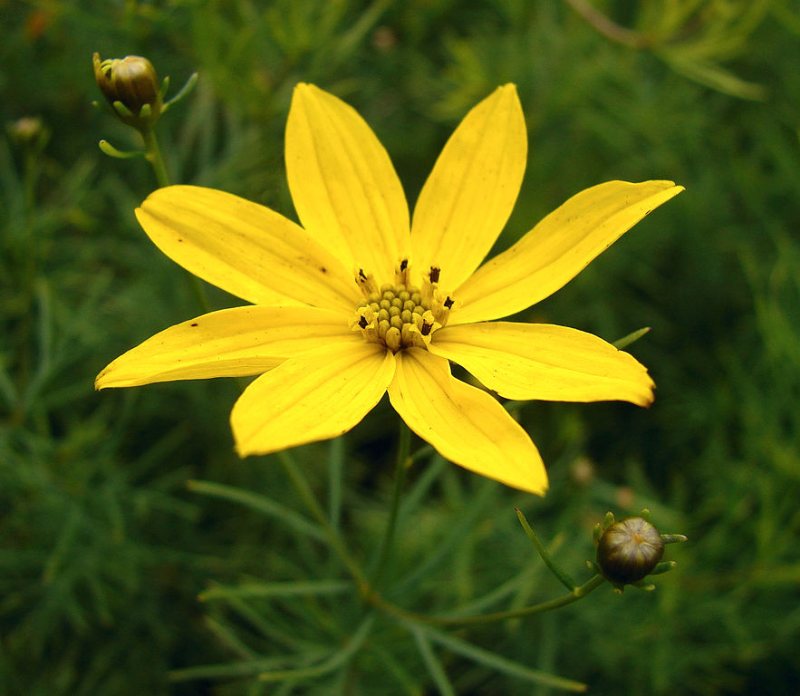
Photo Credit: I, Chrumps / Wikimedia Commons / CC BY-SA 3.0
It’s easy to see why whorled tickseed is part of the daisy family. Like black-eyed Susan and cutleaf coneflower, tickseed is another bright yellow flower. Tickseed flowers are simpler than cutleaf’s, with tickseed having only one layer of petals.
Whorled tickseed has her own uniqueness. Some varieties are exquisitely two-toned. Tickseed requires well-drained soil and will grow well on a property with full sun and some shade.
This herb attracts butterflies, bees, and wasps. Tickseed looks great in containers or borders. Whorled tickseed is not picky about soil type, but soil that is too moist or rich can make the plant stems fragile, causing the plant to flop.
Native Regions: Coastal Plain, Piedmont, Blue Ridge Mountains, and Valley and Ridge
Plant type: Perennial herb
USDA Hardiness Zone: 3 to 9
Sun: Full sun
Soil: Well-drained, moist soils.
Duration: Perennial
Fragrance: Sweet scent
Bloom time: June – August
Water needs: Low to Medium
Mature height: 2 to 3 ft
Potential hazards: None, has medicinal properties
Maintenance: Low
4. Eared Coreopsis (Coreopsis auriculata)
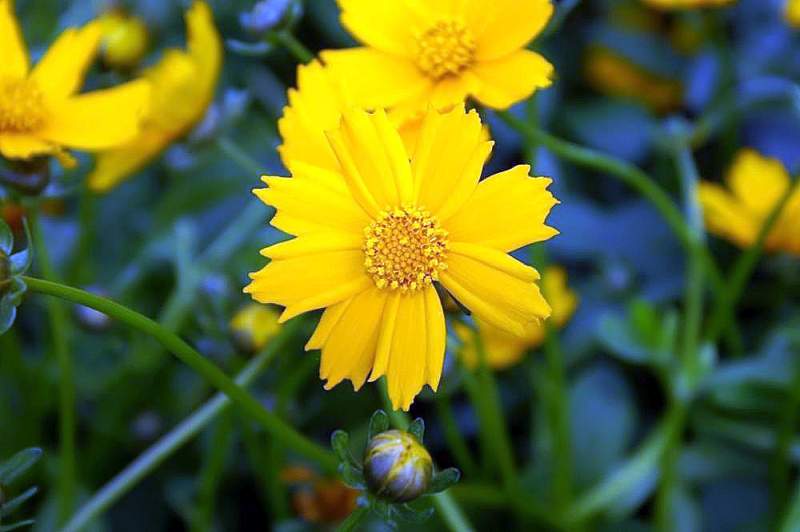
Photo Credit: David J. Stang / Wikimedia Commons / CC BY-SA 4.0
So far, this list is full of brightly colored yellow vegetation. This perennial is no different. Unlike black-eyed Susan, the center of the eared coreopsis is also yellow. The petals have a deeper yellow hue and are contrasted by deeply-green colored leaves. If you want a colorful garden without a lot of work, you’ll be glad to know this flower is low maintenance.
Coreopsis is humidity tolerant. It’s also heat tolerant, making it ideal for the hotter summers in the Tidewater Region. This plant requires well-drained soil and tolerates dry conditions.
Although coreopsis is listed as a perennial, it may die out after two to three seasons. It can also spread quickly and be invasive. Butterflies love this flower.
Eared coreopsis is best when planted in groups. Use this flower to add flavor to border fronts, beds, and cottage gardens.
Native Regions: Coastal Plain (Tidewater), Piedmont, Blue Ridge Mountains, and Valley and Ridge
Plant type: Flower
Hardiness zones: 4 to 9
Sun: Full sun
Soil: Loam, sand, well-drained
Duration: Perennial
Fragrance: Anise-like
Bloom time: Early spring – early summer
Water needs: Low to medium
Mature height: 1 to 2 feet
Maintenance: Low
5. Eastern Redbud (Cercis canadensis)
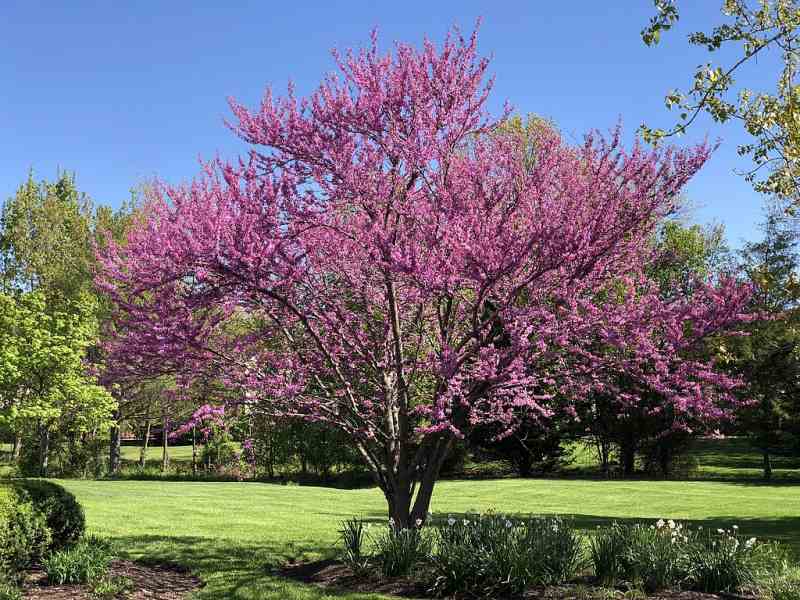
Photo Credit: Famartin / Wikimedia Commons / CC BY-SA 4.0
Also called ace of hearts, the eastern redbud is a strikingly beautiful tree. It has stunning reddish-purplish flowers and leaves the shape of hearts. Don’t blink, because the cluster of colorful petals is only around for two to three weeks.
This plant is pH adaptable, so it is well-suited for your home if you’re unaware of your soil’s pH level. It requires regular fertilization and watering, and its flowers bloom best in full sun. When it gets hot, however, ace of hearts calls for some shade.
It attracts hummingbirds, bees, and butterflies. Eastern redbud can grow up to 30 feet tall and 35 feet wide. Allow it to cast shade in a small garden or serve as shrub borders. It works well as a lawn tree, but it is sensitive to chemicals used for lawns, like herbicides.
Native Regions: All
Plant type: Tree
USDA Hardiness Zone: 4 to 9
Sun: Full sun or partial shade.
Soil: Any moist, well-draining, nutrient-rich soil
Duration: Deciduous perennial
Bloom time: Spring
Water needs: Keep the soil moist to a depth of 2 to 3 inches; watering schedule depends on your soil type, but you should water about once per week
Mature height: 20 to 30 feet tall with a 25 to 35-foot spread
Maintenance: Low. Since this tree is not meant to transplant, it should be planted when young and left undisturbed. It needs little pruning.
6. Flowering Dogwood (Cornus florida)
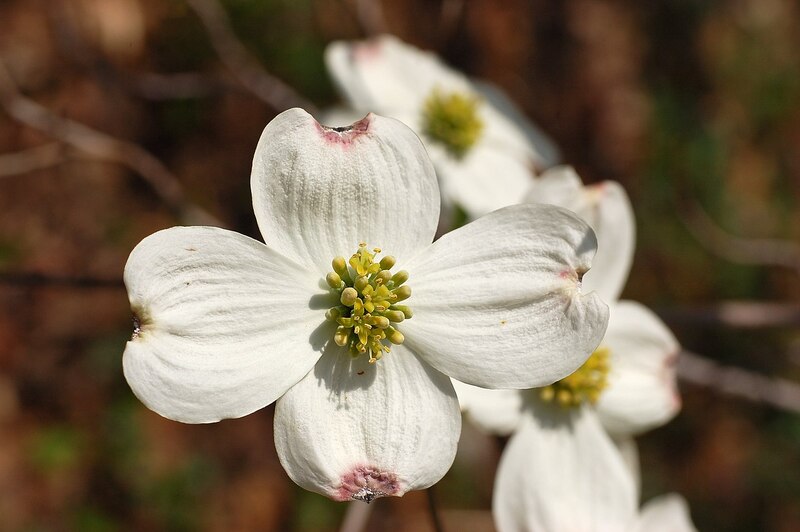
Photo Credit: Derek Ramsey (Ram-Man) / Wikimedia Commons / CC BY-SA 2.5
Flowering dogwood is considered a tree or a large shrub. It has pink and white flowers that curve slightly upward. The red berries feed songbirds from fall through winter. Butterflies are attracted to the flowers that bloom in the spring.
Flowering dogwood is susceptible to a fungal disease that has killed at least 50 percent of dogwood trees. Although this plant prefers partial shade, planting it in full sun lessens the chances of an infection.
When flowering dogwood is developing, it requires irrigation. It may also need weekly watering in the absence of rain. Put mulch around the base of the trunk to keep mowing from damaging it. Be careful not to pile on too much mulch, as it will cause the bark to remain wet, encouraging the growth of disease and insect infestation.
This tree looks stunning as a shade border, shade tree, or next to a patio.
Native Regions: All
Plant type: Deciduous tree or shrub
Hardiness zones: 5 to 9
Sunlight needs: Prefers partial shade but also grows in full sun
Soil preferences: Moist, acidic sandy or loam soils
Duration: Perennial
Bloom time: March – June
Water needs: May need to water once per week when there’s no rain
Mature size: 20 to 40 feet tall and up to 20 feet wide
Potential hazards: Contact with tree may cause skin irritation
Maintenance Needs: Low
7. Blue False Indigo (Baptisia australis)
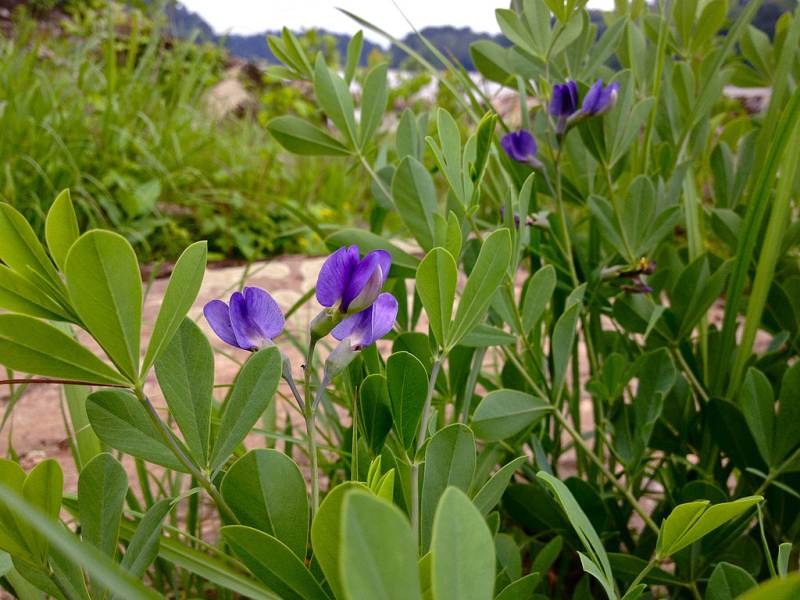
Photo Credit: Fritzflohrreynolds / Wikimedia Commons / CC BY-SA 3.0
All parts of blue false indigo are poisonous. It causes low toxicity when ingested. You may want to keep this plant in an area not easily accessible to young children.
False indigo has lovely blue flowers that stand three to four feet tall. The petals appear for about three weeks. Bees, hummingbirds, and butterflies make themselves at home during this short time span. The leaves pick up the slack and remain once the flowers have left.
A sunny yard will provide a good home for this perennial. Blue false indigo is also drought-tolerant and adapts to poor soil. It’s deer and rabbit resistant. This plant makes a nice addition to borders and beds and also works well on slopes.
Native Regions: Coastal Plain (Tidewater), Piedmont, and Valley and Ridge
Plant type: Upright perennial
USDA Hardiness Zone: 3 to 9
Sun: Full sun
Soil: Loam, Sand
Duration: Perennial
Fragrance: None
Bloom time: April – July
Water needs: Low, Average
Mature height: 3 to 4 feet
Potential hazards: Toxic if ingested
Maintenance: Low
8. Butterfly Milkweed (Asclepias tuberosa)
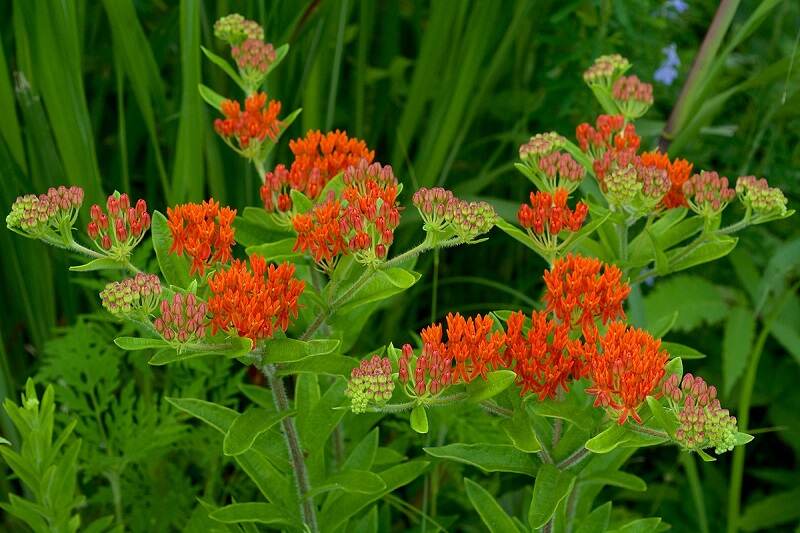
Photo Credit: Eric Hunt / Wikimedia Commons / CC BY-SA 4.0
Butterfly milkweed, commonly called butterfly weed, has showy clusters of orange flowers with yellow highlights. It’s native to all regions of Virginia and most of the United States.
This perennial herb likes a sunny yard and grows well in dry, poor soil. The monarch butterfly depends on butterfly milkweed and other milkweeds for its survival.
Plant this low-maintenance herb in borders, beds, or butterfly gardens. Let butterfly weed rest after planting. It does not do well if transplanted once it’s established. Be mindful that this plant is poisonous if ingested.
Native Regions: All
Plant type: Perennial herb
USDA Hardiness Zone: 3 to 9
Sun: Full sun
Soil: Clay, loam, sand
Duration: Perennial
Fragrance: Vanilla
Bloom time: May – September
Water needs: Low
Mature height: 1 to 2 feet
Potential hazards: Toxic to dogs, cats, horses, and people
Maintenance: Low
9. Cardinal Flower (Lobelia cardinalis)
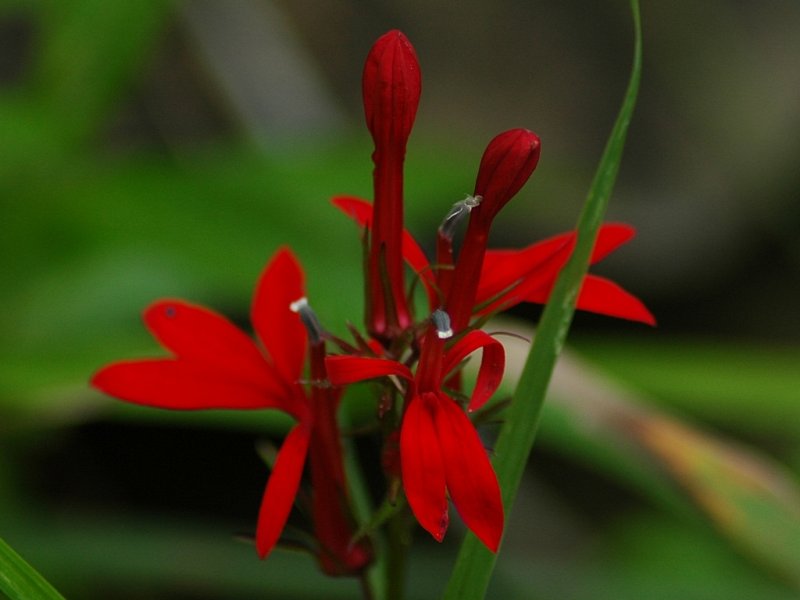
Photo Credit: linnaeus / Wikimedia Commons / CC BY 3.0
If you’re looking for a flower that makes your garden stand out, the cardinal flower is the right plant for you. It has rich, deep, red flowers that blossom from midsummer to early fall, making it a great choice for late summer planting and a burst of fall color.
Cardinal flower is low maintenance and non-invasive. It mostly thrives in the sun but also needs shade in the afternoon. This wildflower will thrive in your yard if your soil is damp and does not drain well. It even tolerates a little flooding.
Cardinal draws in butterflies and hummingbirds. Plant it alongside a pond or in a wild garden. It’s a welcome blast of color in a rain garden or conservation landscaping. Cardinal flower is toxic if large amounts are ingested, so keep this stunning flower out of the reach of small children.
Native Regions: All
Plant type: Flower
Hardiness zones: 3 to 9
Sun: Full sun, partial shade, full shade
Soil: Sand, loam, clay, limestone-based
Duration: Perennial
Fragrance: No floral scent
Bloom time: Fall and Summer
Water needs: Medium to high
Mature height: 1 to 6 feet
Potential hazards: Toxic if large amounts are ingested
Maintenance: Low
10. Swamp Milkweed (Asclepias incarnata)
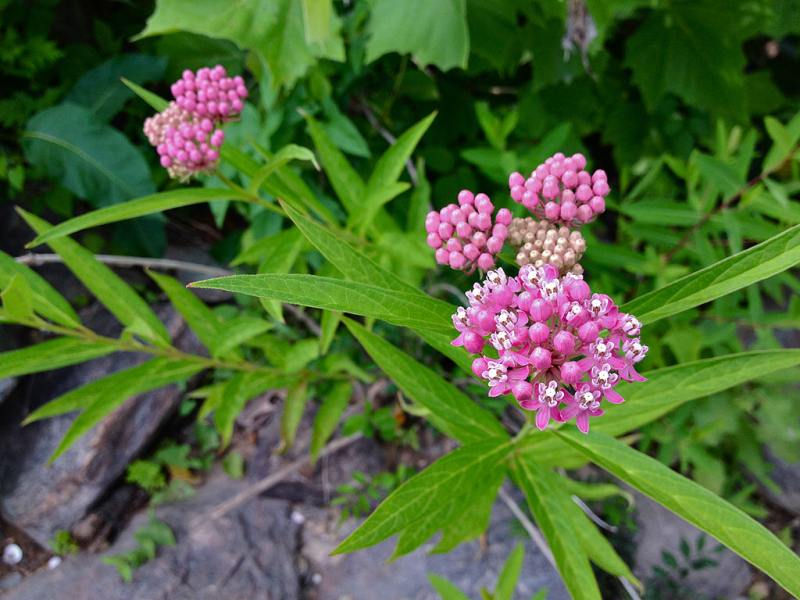
Photo Credit: Fritzflohrreynolds / Wikimedia Commons / CC BY-SA 3.0
Swamp milkweed boasts clusters of small, hot pink flowers. These showy petals attract hummingbirds and butterflies. But be mindful that this milkweed is poisonous if eaten. You may want to take precautions if you have small children or pets.
This flower thrives in medium to wet soils and is usually found in wetlands, so it will be right at home in a rain garden. Add spectacular fall color to your neighborhood by using swamp milkweed in butterfly gardens or near a pond.
Native Regions: All
Plant type: Flower
USDA Hardiness Zone: 3 to 9
Sun: Full sun to partial shade
Soil: Organically rich, slightly acidic, well-drained soil
Duration: Perennial
Fragrance: Sweet smelling
Bloom time: Midsummer to fall
Water needs: High
Mature height: 4 to 6 feet
Potential hazards: Poisonous to humans and animals in large quantities
Maintenance: Low
11. Fall Phlox (Phlox Paniculata)
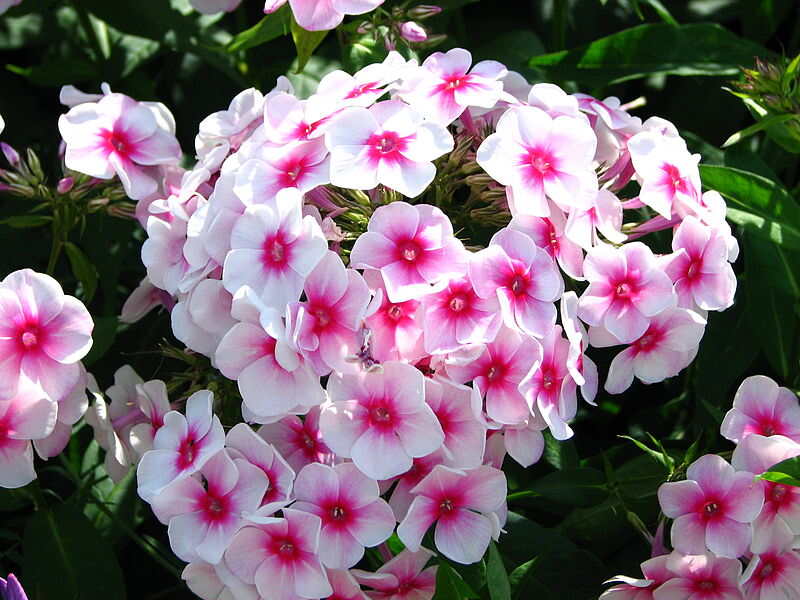
Photo Credit: Kor!An (Корзун Андрей) / Wikimedia Commons / CC BY-SA 3.0
Fall Phlox, also called blue paradise, is naturally found in the southern Appalachian Mountains. This herb blooms lavender flowers atop vines with large, dark green leaves.
Fall phlox is more difficult to grow than many other plants on this list. It is highly vulnerable to many pests and diseases. To manage its susceptibility to powdery mildew, it needs to be planted so that it has adequate airflow. And it should not be watered from the top.
Fall phlox should be removed from the garden in the winter to reduce the chances it will be infected with powdery mildew the next season. This herb attracts birds, hummingbirds, and butterflies.
Native Regions: All
Plant type: Perennial herb
USDA Hardiness Zone: 4 to 8
Sun: Full sun to partial shade
Soil: Chalk, clay, loam
Duration: Perennial
Fragrance: Sweet scent
Bloom time: June – October
Water needs: Medium
Mature height: 2 to 4 ft
Maintenance: Medium
Best Native Plants for Southeast Virginia
Southeast Virginia’s native plants include:
- Red Chokeberry
- Common Buttonbush
- American Beautyberry
- American Witch Hazel
- Common Winterberry
- Eastern Redbud
- Flowering Dogwood
- Black Huckleberry
- Butterfly Milkweed
- Beebalm
Best Native Plants for Northern Virginia
Northern Virginia’s native plants include:
- Red Columbine
- Common Yarrow
- Yellow Wild Indigo
- White Turtlehead
- Maryland Goldenaster
- Spring Beauty
- Eastern Rose-mallow
- Turk’s-Cap Lily
Best Native Plants for Virginia’s Capital Region
Native plants for Virginia’s Capital Region include:
- Black Oak
- Willow Oak
- Sassafras
- Common Partridge Pea
- Smooth Oxeye
- Arrow Arum
- Wild Pink
- Red Chokeberry
How to Choose Native Plants for Your Virginia Yard
Choose plants that are in your USDA hardiness zone. These plants will survive in the lowest temperatures your area experiences.
Also, be mindful that the five Virginia regions comprise multiple counties. Some plants may not be listed as native to all counties within a region. Your local nursery should have information to help you make the best choice.
Consider the characteristics of your property and select plants that thrive well in those conditions. Knowing your soil’s pH balance can help you choose plants that will grow best, unless you opt for vegetation that is pH adaptable.
Be sure to choose plants that accommodate your availability to care for them and your family’s composition. If you have small children or pets, you may want to take special precautions if you choose plants that have potential hazards.
FAQ About Native Virginia Plants
What are the advantages of using native plants?
Using native plants instead of non-native or invasive plants has many advantages for you and the environment. Here are some examples:
- Native plants can mean less work for you. Because they have adapted to the Virginia climate, they require less watering and fertilizing.
- Native plants are less vulnerable to diseases and pests, so they need fewer treatments, if any, with harmful chemicals like pesticides.
- Using fewer pesticides and fertilizers means fewer chemicals run off into the water supply.
- Native plants support and sustain biodiversity and the ecosystem by providing food and habitat to pollinators, other insects, and wildlife.
Can I choose plants in a different USDA hardiness zone than the location I’m in?
Yes, you can. But plants that are not in your zone may take extra work to maintain and keep alive. And, they may not survive your area’s winter temperatures. It’s best to use plants in your zone.
USDA hardiness zones tell you which plants are most likely to survive the area’s lowest temperatures. If you do choose plants outside of your zone, use plants in a lower zone. Plants in higher zones may not survive the lowest winter temperatures in your zone. So, if you live in zone 7a, use plants from zones 1 through 7.
What milkweeds are native to Virginia?
Milkweeds native to Virginia include:
- Common Milkweed
- Swamp Milkweed
- Butterfly Milkweed
- Poke Milkweed
- Whorled Milkweed
- Green Comet Milkweed
- White Milkweed
- Purple Milkweed
Where to Find Native Plants in Virginia
If you’ve been to Green Spring Gardens, you’ve seen many attractive Virginia native plants. You may also find native plants in your neighborhood the next time you’re out for a walk. If you’d like even more ideas for native plants and where to purchase them, the Virginia Native Plant Society is a great resource for garden centers, native plant guides, and other information.
Now that you’ve worked hard to make your home landscape a natural habitat for local insects and wildlife, treat yourself to the ease that comes when experts care for your lawn. The sooner you call a local lawn care professional to ensure your lawn compliments your native flora, the sooner you can enjoy the beautiful water and Virginia’s native scenery.
Connect with trusted pros in Norfolk, Alexandria, Arlington, and many other cities across the state.
Main Photo Credit: Plant Image Library / Flickr / CC BY-SA 2.0